 The
Vakatakas succeeded the Satavahanas in the Deccan. They were powerful rulers
and had matrimonial alliances with the Bharasivas and the Guptas. The Vakatakas
are first mentioned in inscriptions of the second century A.D. from Amaravati.
They thus appear to have migrated from the Krishna valley and established a
kingdom that grew slowly in the later centuries. The Vakataka ruler Pravarasena
appears to have been not only highly literary but also a patron of art and
beauty in all its forms. Some of the caves at Ajanta have inscriptions of the
Vakataka period and can be definitely dated and attributed to the time of these
rulers.
The
Vakatakas succeeded the Satavahanas in the Deccan. They were powerful rulers
and had matrimonial alliances with the Bharasivas and the Guptas. The Vakatakas
are first mentioned in inscriptions of the second century A.D. from Amaravati.
They thus appear to have migrated from the Krishna valley and established a
kingdom that grew slowly in the later centuries. The Vakataka ruler Pravarasena
appears to have been not only highly literary but also a patron of art and
beauty in all its forms. Some of the caves at Ajanta have inscriptions of the
Vakataka period and can be definitely dated and attributed to the time of these
rulers.
While
the early caves show the earlier features of architecture of the Satavahana
period, with typical pillars, facade decoration with railing and chaitya window
pattern, etc., and with the uddesika stupa, devoid of any human representation
of Buddha, when such anthropomorphic representation was considered
disrespectful to the Master, the later caves have the more elaborate pillars
and capitals of the Gupta-Vakataka period, the more developed chaitya window
type and sculptural embellishment, with the uddesika stupa in the chailya,
clearly showing the Master in human form on the sides.
The
sculptures at Ajanta, especially in the later caves, show the high watermark of
perfection during the age of the Vakatakas. There can be no better examples
than these for a study of Vakataka art in the Deccan, coeval with Gupta art in
the north. The paintings completely cover the walls, pillars and ceilings at
Ajanta. They constitute a great gallery of Buddhist art illustrating scenes
from the life of the Master, his previous lives comprising the jatakas and
avadanas and floral and animal motifs. These last are cleverly woven into
diverse designs of great originality.
From an
inscription in Cave 16, it is learnt that it was dedicated to the monks by
Varahadeva, the minister of the Vakataka king Harishena, in the latter half of
the fifth century A.D. In Cave 26 there is another inscription which records
the gift of the temple of Sugata by the monk Biddhabhadra, a friend of
Bhaviraja, the minister of the king of Asmaka. Its date, paleographically,
seems to be the same. A contemporary fragmentary inscription records the gift
of the hall by Upendra in Cave 20. These inscriptions are all in the box-headed
letters of the Vakatakas and help us to understand their date. The art here is
thus of the Vakatakas, just as the earlier phase illustrates Satavahana art.
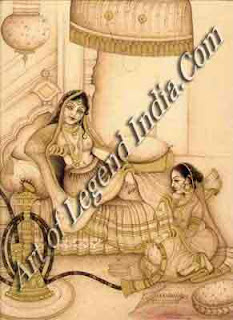
The
mode of painting at Ajanta is the tempera and the materials used are very
simple. The five colours usually described in all the silpa texts are found
here red ochre, yellow ochre, lamp black, lapis lazuli and white. The first
coating on the surface of the rock was of clay mixed with rice husk and gum. A
coat of lime was applied over this, carefully smoothed and polished. On this
ground the paintings were created. The outline drawing was in dark brown or
black and subsequently colours were added. Effects of light and shade were
achieved by the process of streaks and dots illustrating the methods of pat
ravartana, stippling and hatching mentioned in the silpa texts. The lines
composing the figures painted at Ajanta are sure, sinuous, rich in form and
depth and recall the lines in praise of the effective line drawing in the
Viddhasalabhanfika, api, laghu hkhiteyam drisyate purnamurtih, where by a few
lines sketched, the maximum effect of form is produced. The masters at Ajanta
have thus demonstrated the superiority of line drawing as given in the
Vishudharrnottara, rekham prasamsantyacharyah, the masters praise effective
line drawing as the highest in art.
The
painter at Ajanta has studied life around him and natural scenes of great
beauty with intense sympathy and appreciation. Plant and animal life has
interested him considerably. He has lovingly treated such themes of flora and
fauna as he has chosen to depict. The elephants under the banyan tree in Cave 10,
the geese in the Hamsa Jataka from Cave 17, the dear in the Miga Jataka, also
from the same cave, may be cited as a few examples of the tender approach of
the painter to the themes of animals and birds. He has been equally at home in
ably representing the dazzling magnificence of the royal court, the simplicity
of rural life and the hermit's tranquil life amidst sylvan surroundings. The
Vessantara Jataka illustrates the prince as the very picture of magnificence,
as also the simplicity of the hermit and the poor Brahmin as an inexorable
beggar.
The scene in Cave 27 of prince Vessantara, with his consort, driving on
the main road, depicting different merchants in pursuit of their trade, is a
beautiful picture of economic life in ancient India. The landing in Ceylon is a
splendid representation of royal glory in Cave 17. The interior of the palace
giving a glimpse of the king and the queen in the harem or in the garden
reveals that nothing was hidden from the gaze of the court painter. He could
portray the charm of a close embrace, the arm entwining the neck in
kanthaslesha or the sidelong glances of a loving damsel. The toilet of the
princess is another example of a similar theme. Th imagination of the painter
in portraying the celestials has probably no better examples to proclaim its
eminence as the divine musicians floating in the air from Cave 17.
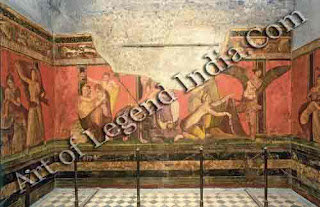 The gay
theme of dampati, or loving couples, has excellent examples at Ajanta. Of this
a whole row is above the entrance doorway of Cave 17. The versatility of the
Vakataka painter in creating diverse poses is here evident in the several
seated dampatis. The artists could so elevate themselves mentally as to be able
to depict magnificently such noble themes as Maraciharshana in Cave 1, Buddha's
descent from heaven at Sankisa in Cave 17, and prince Siddhartha and Yasodhara
in Cave 1, all magnificent representations of the Master in different
attitudes. The long panels and borders from the ceilings of swans and birds,
Vidyadhara couples, auspicious conches and lotuses as well as sinuous rhizomes
and stalks, with lotuses in bud and bloom, and leaves covering large areas
reveal the capacity of the artist to create diverse patterns of great artistic
value.
The gay
theme of dampati, or loving couples, has excellent examples at Ajanta. Of this
a whole row is above the entrance doorway of Cave 17. The versatility of the
Vakataka painter in creating diverse poses is here evident in the several
seated dampatis. The artists could so elevate themselves mentally as to be able
to depict magnificently such noble themes as Maraciharshana in Cave 1, Buddha's
descent from heaven at Sankisa in Cave 17, and prince Siddhartha and Yasodhara
in Cave 1, all magnificent representations of the Master in different
attitudes. The long panels and borders from the ceilings of swans and birds,
Vidyadhara couples, auspicious conches and lotuses as well as sinuous rhizomes
and stalks, with lotuses in bud and bloom, and leaves covering large areas
reveal the capacity of the artist to create diverse patterns of great artistic
value.
The
Vakataka traditions as seen at Ajanta are derived from the earlier Satavahana.
This can be clearly seen in several echoes of the painted figures here from
those of Amaravati. It is mainly the decorative element, chiefly composed of
pearls and ribbons, so characteristic of the Gupta-Vakataka age that
distinguishes them from the simpler but nobler art of the Satavahanas.
The
Vakataka traditions continued in later sculpture. This can be seen in figures
in identical poses found at Mahabalipuram inspired by those at Ajanta which
them-selves in turn recall the earlier ones from Amaravati. The identical twist
of the right leg put forward in exactly the same pose as at Ajanta and at
Mahabalipuram cannot be a chance coincidence. The beautiful paintings in colour
at Ajanta help us to conjecture and fully comprehend the glory of earlier
Amaravati sculpture and the culture it represents. At Amaravati, the lack of
colour precludes the comprehension of the rich jewellery, colourful gems, gay
and glamorous drapery, rich furniture, imposing architecture and pageantry in
the absence of colour.
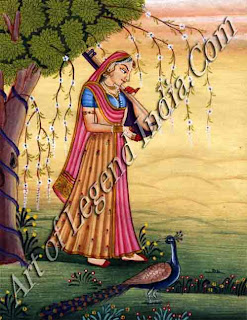
There
are excellent illustrations in these paintings at Ajanta of the six limbs of
painting, shadanga, composed of rupabheda, variety of form, pramana, proper
proportion, bhava, depiction of emotion, lavanya yojana, infusion of grace,
sadrisya, likeness and varnikabhanga, mixing of colours to produce an effect of
modelling. The diversity of form at Ajanta is indeed incredible. The painters
here mastered the vast complex of human, animal and plant form in addition to
giving free scope to their imagination and were creating designs galore. The
master at Ajanta has control over not only the proportions of individual
figures but also has the ability to group them and he has designed excellent compositions.
Emotion is at its best in the narration of scenes from the legends; the grace
in some of the figures bespeaks lavanyayojana. While figures are repeated as
the Vessantara Jataka, the element of portraiture is clearly made manifest and
sadrisya is very obvious. The painter's colour technique easily helps us to pay
him a tribute for his capacity in varnikabhanga.
As a
narrator of the legends, the painter as well as the sculptor at Ajanta has
deviated from the normal course as in other monuments occasionally, but always
the effect has been greater.
Irandati
is shown on a swing in the Vibhurapandita lataka at Ajanta. This enhances the
charm of the Naga princess, the desire to marry whom made the Yaksha Punnaka
play the game of dice, win, and bring the wise Vidhurapandita to the palace of
the Naga queen. It is thus here more beautiful than even at Bharhut or
Amaravati or Borobudur.
The
version of the Chhaddanta Jataka at Ajanta heightens the pathos by the noble
act of the elephant who not only offered his tusks to the wicked hunter but
also helped him even in pulling them out. But this is from the early Satavahana
series in Cave 10 and probably the Vakataka painter followed this earlier
tradition deviating from the normal representation for producing greater
effect.
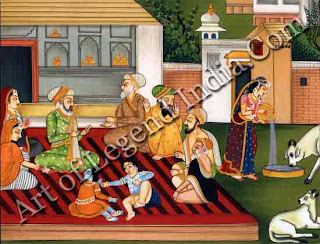
The
Hatnsa Jataka is probably more vivid at Ajanta in painting than even at
Amaravati in sculpture.
But the
detailed and touching story of the Sarna Jataka is probably nowhere better
presented than here in the paintings at Ajanta. There is an elaboration here of
the Vessantara Jataka which makes it probably the best narrative of this story
excelling even that at Goli or at Sanchi.
The
story of Mahakapi Jataka or Sarabhamiga Jataka is different from the stories
usually chosen and depicted in other monuments. The Matiposaka Jataka is again
elaborated here and is different from the simple single scene at Goli.
The
Mahisha Jataka, represented at Borobudur, is a rare one in India and is found
here. The Valahassa Jataka which is represented on a Kushana rail pillar is
better elaborated at Ajanta following the Divyavadana story.
The
Sibi Jataka at Ajanta presents a different version from the one of Kshemendra in
the Avandana kalpalata, the source of which has inspired the scenes at
Amaravati, Nagarjunakonda and other places.
Even in
the scenes from Buddha's life, the master at Ajanta has excelled. The story of
Nalagiri is probably more effectively presented at Ajanta than even at
Amaravati Goli. The same is the case with the presentation of Rahula to Buddha
which is a greater masterpiece at Ajanta than the one at Amaravati though
probably the medallion in the British Museum can stand comparison with any
depiction of this scene from any Buddhist monument in the world.
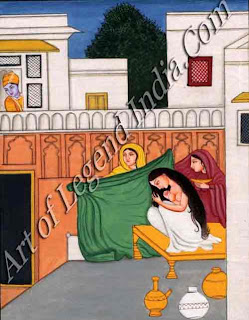
The
descent of Buddha from heaven and the elaborate Maradharshana scene are
unrivalled and probably form the greatest attraction in the scenes from
Buddha's life from the Ajanta caves.
Cave 1
contains great masterpieces illustrating scenes from Buddha's life. A large
panel shows prince Siddhartha and Yasodhara, another Bodhisattva Vajrapani,
Maradharshana, the miracle of Sravasti and the story of Nanda.
The
Master, seated under the Bodhi tree in the Maradharshana episode, is shown
determined to be the enlightened one, unaffected by the temptation of Mara and
his beautiful daughters, and unruffled though attacked and frightened by the
mighty hosts of his opponents.
In the
miracle of Sravasti, Buddha is shown simultaneously in innumerable forms before
a large gathering headed by king Prasenajit. This was to confuse the heretics.
The
story of Nanda gives how, converted, unwillingly, by Buddha, Nanda still longed
for his tear-eyed beautiful wife, Sundari, who pined for him in her palace. The
painting here gives a side picture of Sundari in grief. The jatakas in this
cave include Sibi jataka, Samkhapala fataka, Mahajanaka Jataka and Champeyya
fataka.
The
first narrates how the Boddhisattva offered his own flesh to a hawk to protect
a pigeon that it was after. The Samkhapala Jataka is the story of a Naga prince
who patiently allowed himself to be worried by a troop of wicked men and
rescued by a merciful passerby, gratefully took the latter and entertained him
in his magnificent underground abode. The painting depicts both the happy
situation of the Naga king and his gratitude to his benefactor.
The
Mahajanaka fat aka depicts the story of Mahajanaka who married the princess
Sivali and, in spite of her at-tempts to retain him in worldly pleasures, made
up his mind to be an ascetic, resulting in Sivali following her husband's path.

The
Champeyya Jataka is the story of the Bodhisattva, born as a Naga prince,
Champeyya, who allowed himself to be caught by a snake-charmer and was rescued
by his queen Sumana, by requesting the king of Banaras to inter-cede on her
behalf.
Cave 2
contains a large-size painting of Bodhisattva, the dream of Maya and its
interpretation, the descent from heaven, the birth and the seven steps. The
jatakas depicted here are Hatnsa Jataka, Vidhurapandita jataka, Runt Jataka and
Puma Avadana. There are fragments of painted inscriptions mentioning the
donation of a thousand painted Buddhas as also some verses from the Kshanti
jataka from the jatakantala.
The
Hamsa jataka relates the story of the queen, Khema, who dreamt of a golden
goose preaching the law. She prevailed on her husband the king to get the
golden goose and his companion to be caught by a fowler and brought to her to
give her a discourse on the law. The painting shows the golden goose enthroned and
admonishing the queen. Earlier the capture of the bird by the fowler is shown.
The lotus-lake, the abode of the golden goose, is picturesquely portrayed.
The
Vidhurapandita jataka is the story of the Naga, queen, who desired to listen to
the learned discourse of Vidhurapandita, the wise minister of the king
Indraprastha. According to the story, the beautiful Naga princess Irandati was
promised in marriage to whomsoever brought the heart of Vidhurapandita. The
Yaksha Punnaka won Vidhurapandita as a stake, by defeating his royal master in
a game of dice, brought him to the Naga queen, and thus won the hand of the
Naga princess. The story is elaborately shown here presenting the beautiful
princess Irandati on a swing, the game of dice, Vidhurapandita's discourse in
the Naga palace and the happy union of Punnaka and Irandati.
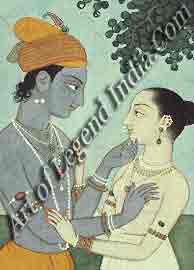
The
Runt Jataka is the story from the Divyavadana of the conversion of Puma by
Buddha and the miraculous rescue of his brother, Bhavila.
The
Kshanti Jataka is the story of a prince who was patience incarnate and put up
with all the persecution he was subjected to by the King of Banaras.
Cave 16
is one of the most beautiful viharas of Ajanta. The inscription in this cave
mentions it as dedicated by Varahadeva, the minister of the Vakataka king,
Harishena, towards the end of the fifth century A.D. The picture given of this
dwelling in this inscription that it was adorned with windows, doors, beautiful
picture-galleries (vithis), carvings of celestial nymphs, ornamental pillars
and stairs and a shrine chaityamandira, and a large reservoir and shrine of the
lord of the Nagas is all borne out quite correctly.
The
paintings here represent the story of Nanda, the miracle of Sravasti, Sujata's
offering, the incident of Trapusha and Bhallika, the incident of the ploughing
festival, the visit of Asita, the prince at school and the dream of Maya.
The
story of Nanda relates to his conversion. When he returned to Kapilavastu,
Buddha visited Nanda's mansion. He was then helping his beautiful wife Sundari
at her toilet. Nanda rose to greet the Master, but Buddha gave him his begging
bowl and bade him to follow him to the monastery. Here he was converted against
his will. However, to make Nanda steadfast in his vows as a monk, Buddha showed
him the most lovely nymphs in heaven, where he conducted him. These he promised
him if he was true to monkhood. Nanda soon became a devoted monk, and realising
the truth of religious life, no more thought of the heavenly damsels. The
scenes here depict Nanda's conversion and his journey to heaven with Buddha to
see the celestial nymphs. This is comparable to the sculptural presentation of
the same theme at Nagarjunakonda. Among the jatakas painted in this cave are
the Hasti Jataka, Mahaummagga Jataka and Sutasoma fat aka.
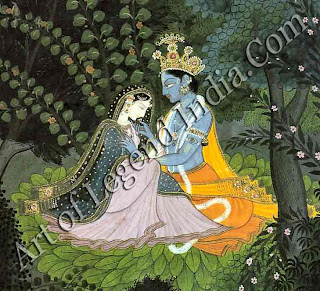
The
Hasti Jataka from the Jatakamala is the story of a noble elephant who killed
himself by falling from a great height to feed a number of hungry travellers.
The Mahaummagga Jataka is a very lengthy one from which an episode is chosen
here for depiction. It is the riddle of the 'son'. Mahosada acted as a judge to
settle a dispute between an ogress and the real mother of the child as both
claimed the little one as their own. Mahosada asked them both to pull the
child. He discovered the real mother in the one who readily gave in when she
could not bear to see the child experiencing such severe pain on that account.
Other riddles like that of the 'chariot' and of the 'cotton thread' from the
same story are narrated further on.
The
Sutasoma Jataka, also from the Jatakamala, narrates how a lioness was
infatuated with a charming prince Sudasa who came hunting to the forest. She
licked the feet of the sleeping prince and conceived a child. When born, this
freak became a cannibal prince, but was finally converted into prince Sutasoma.
The painting shows the lioness licking the feet of the somnolent prince.
As
given in an inscription incised on the wall of the verandah, Cave 17 was
excavated by a feudatory of the Vakataka king, Harishena. It has an elaborately
carved doorway, with a fine floral design. The carvings of Ganga and Yamuna on
the door-jambs are most pleasing.
Noteworthy
among the paintings here are the seven earlier Buddhas, Vipasyi, Sikhi,
Visvabhu, Krakuchchanda, Kanakamuni, Kasyapa and Sakyamuni as well as Maitreya,
the Buddha. to come, the subjugation of Nalagiri, the descent at Sankisa, the
miracle of Sravasti and the meeting of Rahula.
The
jatakas represented here are the Chhaddanta jataka, Mahakapi Jataka I, Hasti
jataka, Hamsa Jataka, Vessantara jataka, Mahakapi jataka II, Sutasoma jataka,
Sarabhamiga Jataka, Machchha Jataka, Matiposaka Jataka, Sama jataka, Mahisha
Jataka and the story of Simhala from Divyavadana with details from Valahassa
jataka, Sibi jataka, Ruru jataka, and Nigrodamiga jataka.
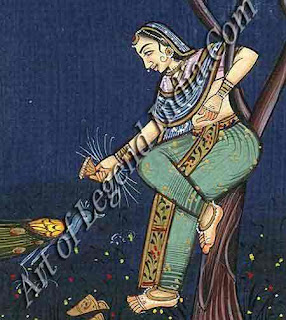
The
Mahakapi jataka I narrates the story of the Bodhisattva, who was born as the
leader of a troop of monkeys. Once, while tasting sweet mangoes on the banks of
the river, the monkeys were suddenly attacked by the archers of Brahmadatta of
Banaras. To save the animals, the Bodhisattva hurriedly stretched out a bamboo
to form a bridge to help them cross over. Finding it, however, slightly short,
he stretched his own body to complete the bridge. The king was touched by the
noble spirit of the animal, honoured him greatly and listened to his discourse
on dharina. The river, the orchard of trees laden with mangoes, the strange
bridge and the sermon of the monkey are all painted.
The
Vessantara jataka has for its theme the life of the noble prince who never
stinted gifting anything begged of him. In fact, he gave away even the precious
elephant, responsible for the prosperity of his realm, which caused him
banishment from his own kingdom along with his wife and children. Finally, he
gave away all that he had, including his chariot and horses and even his
children and wife. The panels here show the banishment, Vessantara leaving the
city in his chariot, his wife in the forest, his gift of his children to wicked
Brahman Jujaka, the restoration of the children to their grandfather and the
happy return of the prince and the princess.
The
Mahakapi Jataka II recounts the tale of the monkey who rescued an ungrateful
man from a deep pit. In spite of the latter's attempt to kill him, the monkey
with a most magnanimous spirit, showed him the way out of the forest. The
scenes depict the animal helping the man out of the pit and the ingratitude of
the latter.
The
Sarabhamiga Jataka gives the story of the king of Banaras helped out of a pit
by a stag.
The
Machchha Jataka narrates the legend of the Bodhisattva, who saved his kin from
death by drought by making a solemn asseveration to bring down rain.
The
Matiposhaka Jataka gives the story of the filial affection of the elephant who
took care of his blind mother. Captured by the king of Banaras, he refused to
touch food till the king, out of compassion, got him to return to his blind
parent. The scenes painted depict the refusal of the elephant to touch food,
his release and happy reunion with his mother.
The
Mahisha Jataka is the story of the Bodhisattva, who patiently put up with the
antics of a monkey.
The
Simhala Avadana narrates the story of Simhala, who accompanied by several
merchants, was shipwrecked on a strange island of demonesses, who in the guise
of beautiful nymphs, lured those unfortunately stranded there and gobbled them
up. The Bodhisattva, born as a horse, offered to rescue the shipwrecked
merchants, but those who stayed behind were destroyed by the ogresses. One of
the latter followed Simhala in the guise of a beautiful woman, with a child in
her arms, and claimed his as her husband before the king, who, struck by her
beauty, made her his queen despite the advice of his ministers. This resulted
in the gradual annihilation of the palace folk that were devoured by the
demonesses. Simhala drove them out, set out with an army to reach their island,
defeated them and became the ruler there.
The
Sibi Jataka gives the story of a king who gladly gave away his eyes to a blind
Brahman at his request, little knowing that it was Sakra himself in disguise.
The panel has a short inscription Sibiraja painted in Vakataka letters.
The
Ruru Jataka gives the story of the capture of the deer to preach the law to the
king.
The
Nigrodhamiga Jataka is the story of the Bodhisattva born as a compassionate
deer, who offered himself to be killed in place of a pregnant doe to feed the
king of Banaras. The ruler was so touched by this act of kindness that he
adored the animal and listened to his sermon on karuna.
Cave 19
has panels representing Buddha with his begging-bowl before his son Rahula and
Yasodhara.
 The
Vakatakas succeeded the Satavahanas in the Deccan. They were powerful rulers
and had matrimonial alliances with the Bharasivas and the Guptas. The Vakatakas
are first mentioned in inscriptions of the second century A.D. from Amaravati.
They thus appear to have migrated from the Krishna valley and established a
kingdom that grew slowly in the later centuries. The Vakataka ruler Pravarasena
appears to have been not only highly literary but also a patron of art and
beauty in all its forms. Some of the caves at Ajanta have inscriptions of the
Vakataka period and can be definitely dated and attributed to the time of these
rulers.
The
Vakatakas succeeded the Satavahanas in the Deccan. They were powerful rulers
and had matrimonial alliances with the Bharasivas and the Guptas. The Vakatakas
are first mentioned in inscriptions of the second century A.D. from Amaravati.
They thus appear to have migrated from the Krishna valley and established a
kingdom that grew slowly in the later centuries. The Vakataka ruler Pravarasena
appears to have been not only highly literary but also a patron of art and
beauty in all its forms. Some of the caves at Ajanta have inscriptions of the
Vakataka period and can be definitely dated and attributed to the time of these
rulers. 
 The gay
theme of dampati, or loving couples, has excellent examples at Ajanta. Of this
a whole row is above the entrance doorway of Cave 17. The versatility of the
Vakataka painter in creating diverse poses is here evident in the several
seated dampatis. The artists could so elevate themselves mentally as to be able
to depict magnificently such noble themes as Maraciharshana in Cave 1, Buddha's
descent from heaven at Sankisa in Cave 17, and prince Siddhartha and Yasodhara
in Cave 1, all magnificent representations of the Master in different
attitudes. The long panels and borders from the ceilings of swans and birds,
Vidyadhara couples, auspicious conches and lotuses as well as sinuous rhizomes
and stalks, with lotuses in bud and bloom, and leaves covering large areas
reveal the capacity of the artist to create diverse patterns of great artistic
value.
The gay
theme of dampati, or loving couples, has excellent examples at Ajanta. Of this
a whole row is above the entrance doorway of Cave 17. The versatility of the
Vakataka painter in creating diverse poses is here evident in the several
seated dampatis. The artists could so elevate themselves mentally as to be able
to depict magnificently such noble themes as Maraciharshana in Cave 1, Buddha's
descent from heaven at Sankisa in Cave 17, and prince Siddhartha and Yasodhara
in Cave 1, all magnificent representations of the Master in different
attitudes. The long panels and borders from the ceilings of swans and birds,
Vidyadhara couples, auspicious conches and lotuses as well as sinuous rhizomes
and stalks, with lotuses in bud and bloom, and leaves covering large areas
reveal the capacity of the artist to create diverse patterns of great artistic
value. 

















0 Response to "Introduction to Vakataka "
Post a Comment